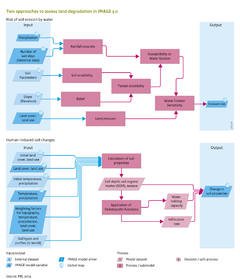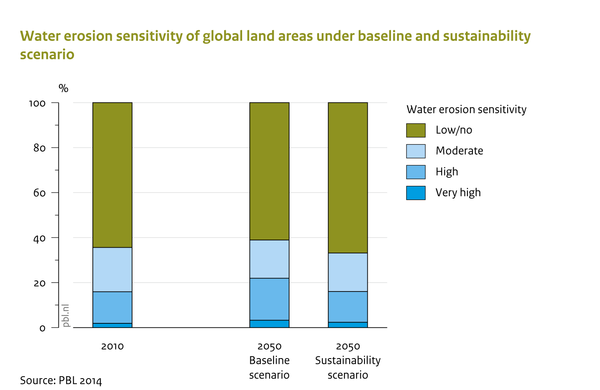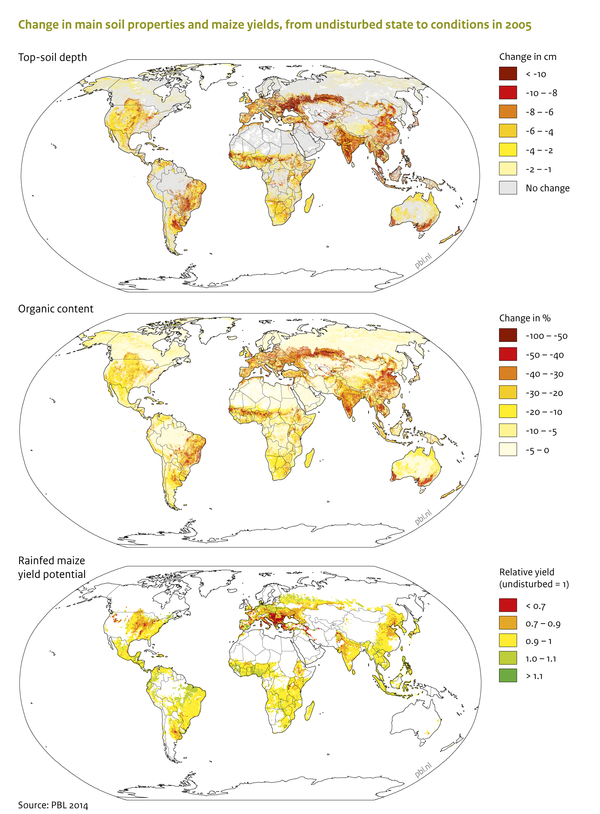Land degradation/Policy issues
Parts of Land degradation/Policy issues
| Component is implemented in: |
|
| Related IMAGE components |
| Projects/Applications |
| Models/Databases |
| Key publications |
Baseline developments
The land degradation model in its current state is used to explore changes in degradation risk over time. Module A for Water Erosion Sensitivity (Flowchart Land degradation) is used to assess risks of soil erosion by water. Resulting maps are used to identify the most sensitive regions, and how areas under different risk categories change over time and space, subject to scenarios of future land use and climate change (the Baseline figure below).
Module B for Human-Induced Soil Changes (Flowchart Land degradation) is used to estimate how historical land degradation propagates through the IMAGE 3.0 framework via change in topsoil depth, soil organic matter content and hydrologic soil properties. As a result of changing soil properties, agricultural productivity calculated by the LPJmL model can change (Figure Policy interventions). This module is used for future projections to assess the effect of climate change , land-use change, land cover change (as vegetation cover), and restoration activities on soil properties, and to study the impact of these changes on crop production, hydrology, and land-use dynamics.
Policy interventions
The modules on soil degradation are used in the IMAGE framework to calculate the impacts of changes in factors driving risks of degradation, such as changes in land use or climate. This is illustrated with the Rio+20 study by comparing the development of the Water Erosion Sensitivity Index under the baseline scenario with a sustainability scenario (Global technology). Areas characterised by high and very high risk increase strongly by 2050 with the development of land use and climate change under the baseline scenario by 33% and 69%, respectively, compared to 2010 levels (Baseline figure above). Under the Global Technology scenario, most of the increased risk is avoided because of less demand for agricultural land and reduction in climate change.
Both modules take into account climate change and land-use change and the effects on erosion risk and soil properties. The modules may be used to assess impact on the erosion risk of all policy interventions affecting climate and land use. However, the modules do not contain specific small-scale measures to reduce the degradation risks, such as reduced tillage and soil conservation practices. Future scenario studies could assess the aggregated effect of land-conservation-oriented policy interventions on the basis of more detailed relationships between agricultural practices and the land use intensity factor, fLUI, in module B.
In the Global Land Outlook 2 report (Van der Esch et al., 2021) - prepared for the convention the combat desertification and land degradation (UNCCD) - the potential of land restoration was assessed using three scenarios: a Baseline scenario where land degradation continues, a Restoration scenario where degraded lands are restored leading to higher crop yields, and a Restoration&Protection scenario where both yield restoration and land protection is included. It is shown that restoration can have substantial benefit for yields, leading to less land use compared to the baseline and reduced food prices implying improved food security. However agricultural land still increases substantially from 2020 to 2050 leading to conversion of natural lands. When land protection is included in the Restoration&Protection scenario also this is prevented, however this does have a negative impact on food security most notably in the countries with high population growth such as in Sub-Saharan Africa.



